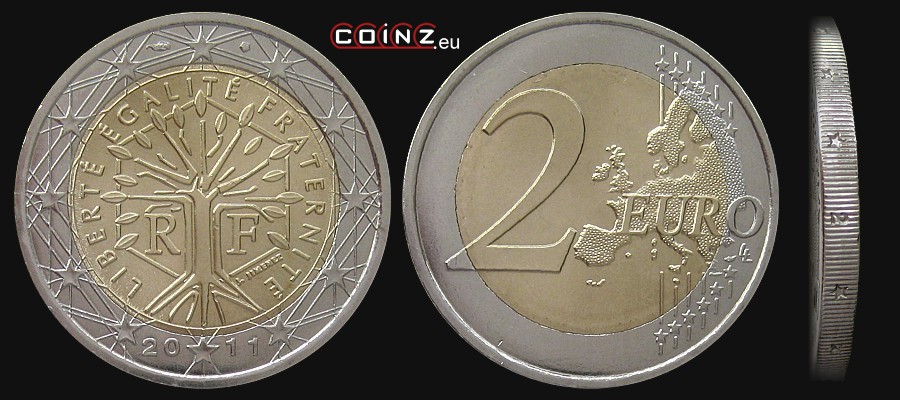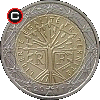2 euro FRANCE (od 2011)


| diameter: | weight: | thickness: | alloy: |
| 25.75 mm | 8.5 g | 2.22 mm | Cu75Ni25/Cu75Zn20Ni5 |
obverse:
in the coin centre a simplified tree; hexagon in the background; on both sides of the tree letters: RF (RÉPUBLIQUE FRANÇAISE - French Republic); along the top edge: motto of France: LIBERTÉ ÉGALITÉ FRATERNITÉ (liberty, equality, fraternity); at the edge a ring of twelve five-pointed stars - symbol of the European Union; the lowest star divides the year of issue
reverse:
edge:
reeded with concave inscription: 

issue date:
1 I 2011
withdrawal date:
in circulation
designer:
Joaquin Jimenez (signature J.JIMENEZ below letter F on the right side of the tree in the obverse), Luc Luycx (initials LL below letter O in EURO in the reverse)
mint:
 La Monnaie de Paris (The Paris Mint), Pessac (mint mark before the highest star in the obverse, after the highest star privy mark of mint's director Hubert Larivière - horn - in years 2007-2010, or Yves Sampo - rosette - from 2011)
La Monnaie de Paris (The Paris Mint), Pessac (mint mark before the highest star in the obverse, after the highest star privy mark of mint's director Hubert Larivière - horn - in years 2007-2010, or Yves Sampo - rosette - from 2011)
mintage:
| 2007 | - | horn | + 60 000 in annual boxed sets |
| 2008 | - | horn | + 60 000 in annual boxed sets |
| 2009 | - | horn | + 60 000 in annual boxed sets |
| 2010 | - | horn | + 55 500 in annual boxed sets |
| 2011 | 36 000 000 | rosette | + 45 500 in annual boxed sets |
| 2012 | 37 000 000 | rosette | + 42 000 in annual boxed sets |
| 2013 | 17 000 000 | rosette | + 28 000 in annual boxed sets |
| 2014 | 9 000 000 | rosette | + 28 000 in annual boxed sets |
| 2015 | 15 000 000 | rosette | + 28 000 in annual boxed sets |
mint marks:
interesting facts:
In the coin obverse there is a hexagon (in French l'Hexagone), which is among the French a nickname for their country. Indeed the shape of the Metropolitan France reminds this geometric figure.
last update: 12 VIII 2015
coins catalogue :: katalog monet :: münzkatalog :: catalogue de monnaies :: catálogo de monedas :: catalogo monete :: каталог монет :: κέρματα κατάλογος :: COINZ.eu
© 2010-2025 :: Adam Kubicki :: COINZ.eu :: All rights reserved.


